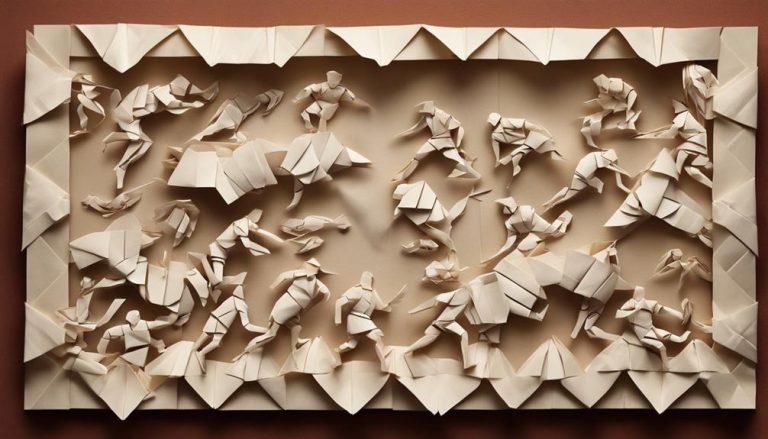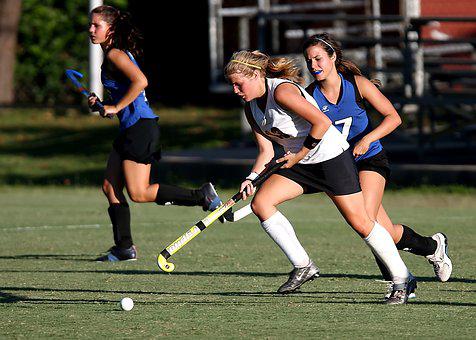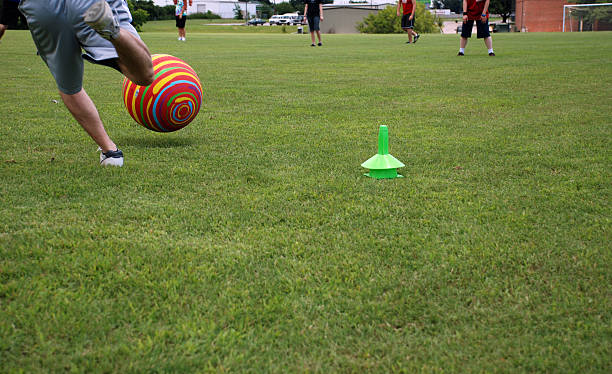General Rules of Gaelic Handball
To master Gaelic Handball, you must understand the court dimensions; 40 feet long and 20 feet wide. Player positioning is key for strategic advantage. Serving involves hitting the front wall with precision and control. Vary your shots to keep opponents off balance. Know the boundaries to avoid point deductions. Hand signals help maintain game flow and fairness. Proper gear boosts performance and safety. Learn the fundamental rules for a competitive edge.
Court Dimensions
When discussing Gaelic Handball rules, understanding the court dimensions is essential for players to navigate the game effectively. The court is typically 40 feet long and 20 feet wide, providing ample space for strategic plays and quick movements. Player positioning plays an important role in Gaelic Handball, with competitors needing to adapt to the court's dimensions to gain an advantage over their opponents.
Proper player positioning involves being aware of the court's boundaries and utilizing the space efficiently. By understanding the dimensions of the court, players can position themselves strategically to anticipate their opponent's moves and react swiftly. This positioning is crucial for both offensive and defensive plays, allowing players to control the pace of the game and capitalize on scoring opportunities.
Mastering player positioning within the court dimensions is key to excelling in Gaelic Handball. It enables players to maintain control over the game, outmaneuver their opponents, and showcase their skills effectively. By honing their understanding of court dimensions and player positioning, competitors can elevate their gameplay and achieve success in Gaelic Handball.
Serving Rules
Understanding the serving rules in Gaelic Handball is important for players to initiate each point effectively and adhere to the game's regulations. When it comes to serving technique, players must strike the ball with their hand, ensuring it hits the front wall first without touching the ground. This requires precision and control to set the tone for the rally. Additionally, etiquette plays a significant role in serving, with players expected to wait for their opponent to be ready before starting the serve, showing respect for fair play.
In terms of strategy, serving in Gaelic Handball can be a strategic advantage. Players can vary their serving positioning to keep their opponent guessing, whether aiming for a low shot close to the side wall or a high lob to the back. This variability can disrupt the opponent's rhythm and give the serving player an edge in the point. Proper positioning before serving is also essential, as it can dictate the flow of the rally and set up advantageous court positioning. Mastering the serving rules, technique, and strategy is key to gaining an upper hand in Gaelic Handball matches.
Scoring System
The scoring system in Gaelic Handball operates on a rally-point system, meaning that a point is scored by the serving player or team regardless of who served. This system adds an exciting dynamic to the game, where every serve has the potential to earn a point. To excel in Gaelic Handball, mastering scoring techniques and player strategies is vital. Here are some key points to keep in mind:
- Vary Your Shots: Mixing up your shots with power shots, ceiling shots, and kill shots can keep your opponent off balance.
- Control the Game Tempo: Dictating the pace of the game can disrupt your opponent's rhythm and give you an edge.
- Maintain Mental Focus: Staying mentally sharp throughout the match is essential. Avoid getting distracted and stay focused on executing your game plan.
Understanding these aspects of scoring techniques, player strategies, game tempo, and mental focus will enhance your performance on the Gaelic Handball court.
Out of Bounds
When playing Gaelic Handball, understanding the court boundary rules is essential to avoid losing points due to out of bounds shots. Player boundary violations occur when players step outside the designated playing area during the game, resulting in point deductions. Being mindful of these boundaries will help you maintain a strong position and maximize your scoring opportunities.
Court Boundary Rules
Understanding the court boundary rules in Gaelic Handball is essential for players to grasp the limits of play. When on the court, remember these key points:
- Court Boundary Strategies: Utilize the court boundaries to your advantage by positioning yourself strategically to control the game.
- Player Positioning: Stay mindful of your position within the court to maximize your ability to return shots effectively.
- Off Court Distractions: Maintain mental focus by blocking out external distractions and staying fully engaged with the game.
Player Boundary Violations
To avoid player boundary violations in Gaelic Handball, it is important to be aware of the court boundaries and make sure your positioning remains within the designated playing area. Player conduct in Gaelic Handball is vital to maintaining the integrity of the game. Being mindful of the boundaries not only showcases good sportsmanship but also guarantees fair play. Violating player boundaries can result in penalties or even disqualification, impacting not only your performance but also the overall flow of the game. Upholding sportsmanship expectations includes respecting the boundaries set for the game, which ultimately contributes to a more enjoyable and competitive environment for all players involved. By adhering to these rules, you demonstrate a commitment to the principles of Gaelic Handball and enhance the experience for yourself and your fellow players.
Player Positions
In Gaelic Handball, player positions play an important role in determining the strategic dynamics of the game. Understanding where players are positioned on the court can greatly impact player strategy and overall team dynamics. Here are key points to keep in mind regarding player positions:
- Player Strategy: Each player's position on the court influences their strategic approach to the game. Whether focusing on offense or defense, players must adapt their tactics based on their designated position.
- Team Dynamics: The combination of player positions within a team creates a unique dynamic that affects how the team functions as a whole. Working together cohesively, players can leverage their positions to maximize performance.
- Offensive Tactics and Defensive Positioning: Player positions dictate not only offensive tactics but also defensive strategies. Understanding the intricacies of positioning can help players anticipate and counter their opponents' moves effectively.
Handball Contact
Players in Gaelic Handball must navigate the intricacies of handball contact, which greatly impacts gameplay dynamics and strategic choices on the court. Understanding the rules surrounding physical contact is essential to guarantee fair play and player safety. In Gaelic Handball, there are strict regulations in place to govern the level of physical contact allowed during gameplay. These rules aim to balance the competitive nature of the sport with the need to protect the players from unnecessary risks.
Player safety is a top priority in Gaelic Handball, and the regulations regarding handball contact reflect this commitment. While the sport allows for a certain degree of physicality, there are clear boundaries that players must not cross to maintain a safe environment on the court. By adhering to these guidelines, players can engage in intense matches while minimizing the risk of injuries.
Referee Signals
Referee signals play an important role in maintaining order and clarity during Gaelic Handball matches, ensuring that players and spectators can easily interpret the decisions made on the court. When it comes to referee communication and player gestures, these signals are vital for keeping the game flowing smoothly and fairly.
- Clear Hand Signals: Referees use distinct hand signals to indicate different calls or decisions, such as a hinder, a point, or a replay. Understanding these signals can help players react accordingly during the game.
- Consistent Non-Verbal Cues: Non-verbal cues given by the referees help in maintaining the game flow without disrupting the momentum. These cues can include eye contact, body positioning, or subtle gestures that convey important information to the players.
- Enhancing Game Flow: By efficiently using referee signals, the game's pace is upheld, and interruptions are minimized. This contributes to a more engaging and dynamic gameplay experience for both players and spectators.
Equipment Requirements
When it comes to playing Gaelic Handball, the equipment requirements are essential for a successful game. Essential gear includes proper handball gloves, which not only protect your hands but also enhance your grip and control of the ball. Understanding the importance of these equipment points will help you perform at your best on the handball court.
Essential Gear for Play
To engage effectively in Gaelic handball, appropriate gear is crucial to guarantee safety and enhance performance on the court. When gearing up for a Gaelic handball match, consider the following essential items:
- Protective Eyewear: Shield your eyes from potential injuries caused by fast-moving handballs.
- Non-Slip Court Shoes: Ensure a firm grip on the court surface for quick movements and stability during gameplay.
- Moisture-Wicking Clothing: Stay comfortable and dry with breathable fabrics that help manage sweat during intense matches.
Having the right gear not only safeguards you during gameplay but also boosts your performance on the Gaelic handball court. Remember, safety and comfort are key to mastering handball techniques and optimizing game strategies.
Proper Handball Gloves
Having the appropriate handball gloves is crucial for players aiming to optimize their performance and guarantee a secure grip during Gaelic handball matches. When selecting handball gloves, consider the material and sizing options available to ensure a comfortable and effective fit. Here is a breakdown to guide your decision-making:
| Glove Material | Description |
|---|---|
| Leather | Provides durability and a natural feel for the ball. |
| Synthetic | Offers enhanced breathability and flexibility. |
| Rubber | Enhances grip and control during gameplay. |
| Sizing Options | Fit |
| Small | Snug fit for players with smaller hands. |
| Medium | Standard fit suitable for most players. |
| Large | Roomier fit for players with larger hands. |
Choosing the right handball gloves can have a significant impact on your performance on the court.
Substitution Guidelines
Understanding the substitution guidelines in Gaelic Handball is essential for players and coaches alike to guarantee seamless gameplay changes. When it comes to player substitutions, strategy plays an important role in maintaining momentum and adjusting to the flow of the game effectively. Team communication is key to executing substitutions smoothly, ensuring that players are aware of their roles and responsibilities. Rotations within the team should be well-coordinated to maximize each player's strengths and keep the team competitive throughout the match.
In Gaelic Handball, strategic substitutions can be game-changers, allowing teams to adapt to their opponents and capitalize on opportunities. Coaches must communicate their substitution plans clearly, emphasizing the importance of timing and player positioning. Understanding when to make substitutions based on the game situation is crucial for success. By implementing a well-thought-out substitution strategy and maintaining open lines of communication, teams can optimize their performance and stay ahead of the competition.
Match Etiquette
When participating in Gaelic Handball matches, it is vital to respect your opponents' space to guarantee fair play. Following the decisions made by referees is necessary for maintaining order and upholding the integrity of the game. Demonstrating good sportsmanship throughout the match fosters a positive playing environment for all involved.
Respect Opponents Space
Respecting your opponent's personal space during a Gaelic Handball match is a fundamental aspect of displaying sportsmanship and fair play. It not only shows respect but also contributes to a positive and amicable atmosphere on the court. To guarantee you uphold this principle effectively, consider the following:
- Maintain Distance: Give your opponent adequate space to move freely without feeling crowded.
- Show Sportsmanship: Demonstrate courtesy and respect towards your opponent by avoiding unnecessary physical contact or invasion of their space.
- Prioritize Fair Play: By honoring your opponent's space, you uphold the spirit of fair competition and promote a healthy playing environment for everyone involved. Remember, a little consideration can go a long way in fostering a positive sporting experience.
Follow Referees Decisions
Adhering to referees' decisions is vital for maintaining order and fairness in Gaelic Handball matches. Respect for referee authority is essential to uphold the integrity of the game. Player dissent can disrupt the flow of the match and create unnecessary tension. It is important for players to accept calls made by the referees, even if they disagree. Remember, referees are there to guarantee fair play and make impartial judgments. Challenging every call can lead to a negative atmosphere on the court and detract from the overall enjoyment of the game. Embracing a mindset of sportsmanship involves trusting in the referees' decisions and focusing on playing your best game within the rules.
Maintain Sportsmanship Throughout
To maintain sportsmanship throughout a Gaelic Handball match, it is important to uphold respect for the game and fellow players, ensuring a positive and fair playing environment. Sportsmanship and teamwork are essential components that contribute to the overall experience of the game. Here are some key points to ponder:
- Respect Your Opponent: Treat your opponent with respect, acknowledging their skills and efforts.
- Follow the Rules: Adhere to the rules of the game and accept the decisions made by officials.
- Encourage Fair Play: Promote fair play among teammates and opponents, fostering a competitive yet respectful atmosphere.
Frequently Asked Questions
Are There Any Specific Strategies or Tactics That Players Can Use to Improve Their Chances of Winning a Gaelic Handball Match?
You might think Gaelic handball is just about hitting the ball hard, but strategic defensive plays and clever offensive tactics can turn the tide. Mental preparation and match analysis are key to success.
How Does the Speed and Power of the Ball Affect Gameplay in Gaelic Handball?
When the ball in Gaelic handball gains speed and power, its trajectory impacts gameplay notably. The force behind the ball demands quick reactions from you, forcing strategic positioning and rapid responses from your opponent.
Can Players Use Their Non-Dominant Hand During a Match, or Are They Required to Only Use Their Dominant Hand?
Can players use their non-dominant hand during a match, or are they required to only use their dominant hand? Being ambidextrous in Gaelic handball can provide a competitive advantage, offering flexibility and unpredictability in gameplay.
Are There Any Specific Training Exercises or Drills That Players Can Do to Improve Their Handball Skills?
To enhance your handball skills, focus on strength training to improve power and coordination drills for better control. Incorporate footwork exercises to enhance agility and reaction speed drills for quicker responses on the court.
How Do Weather Conditions, Such as Wind or Rain, Affect Gameplay in Gaelic Handball Matches?
In Gaelic handball, weather conditions like wind can alter the ball's trajectory, challenging your game. Rain may lead to a slippery court, affecting movement. Imagine this: Wind resistance might make that winning shot more elusive.






